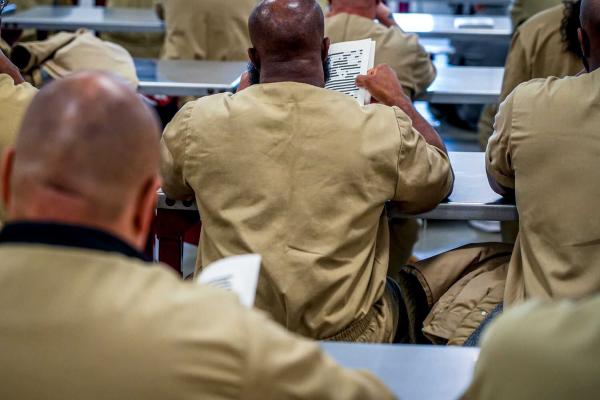When I was 12, I saved my allowance all month so that, on release day, I could walk to the bookstore near my house and buy the latest Goosebumps book by R. L. Stine. The books feature young teen protagonists in various horror scenarios (mad scientist fathers, haunted ventriloquist dummies, mirrors that suck you into an alternate reality and replace you with your mirrored doppelgänger). The kicker is that they always end with a twist: the monster vanquished, normalcy restored. And then a final scene where we find out the monster isn't dead!
My burgeoning horror obsession came of age in the wake of the satanic panic of the 1980s, when evangelical churches saw satanic purpose behind every cultural movement and in every album (as long as you played it backward). Preachers, youth pastors, and concerned parents warned us constantly against the pop culture schemes of the devil. They used Paul's admonition to the Philippians: “Finally, beloved, whatever is true, whatever is honorable, whatever is just, whatever is pure, whatever is pleasing, whatever is commendable, if there is any excellence and if there is anything worthy of praise, think about these things” (4:8). For most evangelicals, any one of those virtues disqualified horror wholesale.
Should Christians have anything to do with horror? Is there anything commendable or worthy of praise in the genre?
As a pastor whose love of horror has only deepened over the years, I offer a resounding yes. Horror is a genre uniquely able to invite us into spaces of confession and lament, if only we have ears to hear.
Monster stories are warnings. The word monster comes to us from the Latin word monstrum, which means omen. Monsters point toward some deeper reality. The grandfather of “monster theory,” Jeffrey Jerome Cohen, outlined theses of monster theory in 1996. As his interpreter Jeffrey Andrew Weinstock summarizes, “Monstrosity is a socially constructed category reflecting culturally specific anxieties and desires, and often deployed — wittingly or not — to achieve particular sociopolitical objectives.”
Throughout history, storytellers have used monsters to embody particular social anxieties. Zombies, for instance, originated in Haiti, as a corpse reanimated by a houngan, a male Voudon priest. The zombie had no will, wholly subservient to their master: a slave monster. Many enslaved peoples drew hope from the promise of freedom in the afterlife, when that sweet chariot would swing low to carry them home. The zombie embodied a fear that they could be enslaved even after death.
The zombie didn’t stay in Haiti. Through filmmaker George Romero, they immigrated to the United States, first as ghouls in his original Night of the Living Dead and then as a metaphor for capitalism (read: mindless consumerism) in the sequel, Dawn of the Dead, where the humans are trapped in a mall. Zombies are anything but subtle.
Today's zombie stories — The Walking Dead, 28 Days Later, or Army of the Dead — feature the latest incarnation of the zombie: the mindless hordes who sweep through our communities destroying everyone and everything. For pop culture critic Dhalia Schweitzer, today’s zombie narratives are “a reflection of a larger tendency to position the elite at war against the masses, the special few against the undifferentiated and perpetually hungry many.” That's right: We’ve turned a monster that reflected the anxieties of an oppressed people who hungered for liberation into a nightmare of the privileged — a scenario where oppressed people will rise up and consume us all.
Or consider the slasher: A socially stunted man wields a phallic weapon to kill the teens who are into sex, drugs, and rock-n-roll; he can only be slain by the virginal “final girl.” With her “final girl” theory, professor and film critic Carol J. Clover has made us aware that slasher films embody a surprisingly conservative sexual ethic. The Michael Myers and Jason Voorhees of cinema, demented though they may be, uphold patriarchal values. They restore an order that persists after they’re slain … at least until the sequel.
But slasher movies, too, have been around long enough to be ripe for subversion.
So Get Out opens not with a white woman walking alone, but a Black man in the suburbs. The film employs classic slasher tropes to tell a new story about the monstrosity of white liberal racism. Get Out recognized that patriarchy isn’t just about sexual mores; patriarchy also requires conformity to whiteness. So Chris discovers that Allison and her nice, white, liberal family aren’t interested in him — just his body. They want to remove his mind and graft an old white man into him — a potent metaphor for the way whiteness appropriates Black bodies for their own agenda rather than centering Black persons.
This year's Candyman reboot engages the original Black slasher, summoning him to weaponize Black suffering and fight back against racialized violence. The original Candyman, released in 1992, featured the titular hook-handed slasher as an embodiment of Black pain. Before becoming a monster of Chicago’s ghetto, where he killed anyone who said his name five times in front of a mirror, he was a successful Black artist in the 1800s, lynched for falling in love with a white woman. But the original Candyman only attacked a white woman, who was researching urban legends in the Cabrini-Green complex, when she ventured into the projects.
The 2021 Candyman centers not on a white woman, but a Black man, an artist who is part of the first gentrifying wave to sweep through Cabrini-Green (again mirroring real-world Chicago). By the end of the film, he has become the latest Candyman, and his wrath turns not on his Black neighbors, but on the white system that created the ghettos of the United States in the first place. The whole film is an inversion of the way our culture has demonized Black bodies, a reality illustrated by hip-hop artist Damac's music video “Monster.”
The slasher has morphed from a monster that reinforces patriarchy to a site of resistance and revolution. Horror can be a tool for liberation. (This is true outside the United States as well. Guatemalan film La Llorona is a ghost story that grapples with the legacy of genocide, while Sylvia Moreno-Garcia's novel Mexican Gothic meditates on the legacy of colonialism.)
So what does all this mean for churches? Horror by nature unsettles us — that’s what those twist endings in the Goosebumps books were all about. Horror insists the monster is under the bed, that the call is coming from inside the house. Horror disrupts our safe spaces, unsettles our calm and quiet.
Perhaps that’s why we think horror is the enemy of religion. After all, many of us turn to religion for comfort and security — something cultural critic Aja Romano observed in her divisive review, “Why I felt Betrayed by Netflix’s Midnight Mass.” Early in the article, she states that “Religion is all about offering people comfort, and horror is all about stripping it away.” No surprise, then, that in considering the series’ apocalyptic finale, she said, “The sheer horror of this moment — that the townspeople are so consumed with religion that it has destroyed them — gets subsumed in a wash of rosy cinematography and the moving strains of ‘Nearer, My God, to Thee.’” Horror is designed to disrupt comfort. To insist that all is not, in fact, okay. Horror is about twist endings, not happy endings.
But religion can — and should be — disruptive as well. Jesus regularly scandalized those around him by rejecting his family, by feasting with tax collectors and sinners, by touching lepers. And in the end, Jesus became the monstrous — stripped naked and driven out of the city to the wilderness (like Azazel’s goat in Leviticus 16) before being executed. Jesus insisted the way of Rome was not okay, that the Pax they promised needed to be disrupted. So Jesus became the monster, his Passion play a horror production complete with blood and gore, torture and death.
Horror can create space for us to lament. If we will sit with our monsters, we might find that the calm we have mistaken for peace shields us not from outside terrors, but our own sin. Those monsters turn out to be those we oppress — their mouths open not to destroy but to cry for justice.
In his first epistle, John the Elder insisted that “there is no fear in love, but perfect love casts out fear” (4:18). The First Nations Version captures the sense of the Greek more readily, rendering “perfect” as “mature.” Perfected love — mature love — casts out fear. Mature love recognizes that it is a gift to be unsettled, because that discomfort enables us to see where we have conquered and colonized when we should have been loving our neighbors as ourselves.
This is, perhaps, the greatest gift of horror: If we will sit with our monsters, we will discover they are our neighbors. Horror can teach us to spot monsters, to recognize our own tendency to create monsters out of others, dehumanizing them. Horror can challenge how we demonize the other in order to justify exorcising them without guilt.
But the cross creates the most shocking twist of all: God became monstrous for our sakes. How, then, can we justify crucifying those we find monstrous? As Jesus warns, they might just turn out to be him.
Got something to say about what you're reading? We value your feedback!







